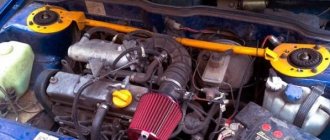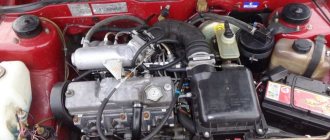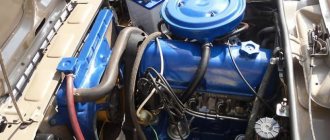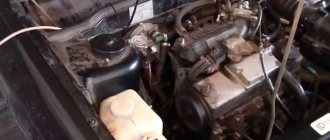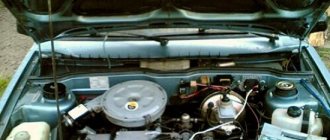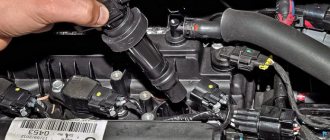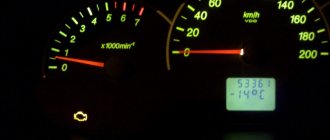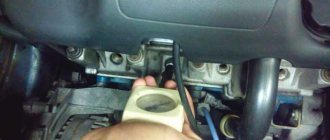If you, in the company of your friends, say that your engine is missing, they may misunderstand you or simply look at you with “square” eyes... It’s a different matter if you complain that the engine is missing or your one of the cylinders is working, in which case you will receive a large number of different versions and assumptions taken supposedly from personal experience, as well as advice on what needs to be done in this case. You can, in principle, listen to the advice of friends, there is nothing wrong with that, but I would also recommend listening to the opinions of experts on this matter. In my article today, I will talk about what engine tripping is and where it comes from, you will learn about the causes of this unpleasant phenomenon, as well as ways to eliminate this malfunction. Armed with the information I needed, I decided to visit the mechanics at one popular bus station in our city, in order to find out whether the various “experts” wrote on the forms were true and whether they should be trusted. Simply put, I decided to ask why the engine troubles those who are directly related to this.
Reason one - spark plugs
I wrote in detail about how to determine faults in car systems using spark plugs here .
I recommend reading it - it turned out to be useful, judging by your reviews, thank you.
We unscrew the spark plugs one at a time and look at their insulator.
If it is covered with dense carbon deposits, then it is difficult for a spark to penetrate it. The current seeks the path with the least resistance, so the spark will not be between the electrodes, but will “go” along the insulator to the side. Its energy will not be enough to set fire to the air-fuel mixture. This cylinder will not work.
We inspect the external condition of the spark plug insulator.
If there are microcracks, then part of the current will not be converted into a discharge, but will escape through these damages. You need to look at the internal insulator, which is screwed into the cylinder head, and at the external one, onto which the armor wire cap is placed.
Large or small gap between electrodes.
Many people have heard or know that for certain engines, ignition systems and types of fuel used, spark plugs with a certain gap are required. Usually its value is indicated by the manufacturer of engines and cars.
How to check the spark without special devices on the engine
This is an old, “grandfather” method, some people are afraid of it:
- They unscrewed the spark plug;
- They put an armored wire on her;
- They leaned it with the inner body, the metal part, against the engine;
- Turn on the ignition and turn the starter.
We look at the spark when trying to start the engine. If it hits clearly between the electrodes, is bright, and does not move to the side, then the candle is “live”. Screw it into place. Let's move on to another “subject”.
What to do with black carbon
First of all, let's look at the cause of the rich mixture. It is this that is the source of this deposit on the electrodes. Perhaps it appeared as a result of the “dying” of the spark plug, when the fuel stopped igniting normally. This soot was deposited on the electrodes and insulator.
We try to clean the spark plug with sandpaper. We only clean the electrodes themselves; there is no need to touch the insulator. We install it in place, start it and listen to the engine.
What to do with a large or small gap
Many Zhiguli owners know how to adjust it themselves. To do this, you will need a set of probes of different thicknesses, a hammer or pliers.
- Let's find out what interelectrode gap is recommended for your engine. For example, on Zhiguli cars with a contactless ignition system, 0.7-0.8 mm is recommended;
- We take the probes, find the appropriate size and put them between the electrodes of the spark plug;
- If it climbs freely, gently tap the side electrode with a hammer (not a sledgehammer) or pliers. Sometimes it’s enough to press hard and the electrode will give way. We measure again, if it flies by again with a whistle, we bend it again;
- If it doesn’t fit through, bend it over the edge of the side electrode with pliers. It is advisable to do this with a thin screwdriver. We insert it between the electrodes and bend the central one a little.
Loss of power 2105
The well-known term “loss of engine power” includes many reasons and also a description of these reasons all over the Internet - wear of pistons with rings, lack of clearance in the contacts of the distributor (distributor), incorrect adjustment of valves and ignition timing.
But these reasons lead to a loss of power gradually: first, the engine begins to start worse, the car goes up the usual hill in a low gear, etc. An instant loss of power can occur when the carburetor jets become clogged. But the incident that occurred with the loss of power of my five (2105) showed that there may be another reason that the service station could not determine. How it was. In the evening I put the car in the garage in “full health”, in the morning it started up well, but when I started driving, something called “loss of power” occurred. In first gear the car started moving, and then the engine did not gain speed and even stalled. What immediately came to mind? Of course, the jets in the carburetor were clogged. I quickly removed the top cover of the carburetor, unscrewed the jets, blew them out, put them back in place, washed my hands and got ready to go, but nothing happened! I performed the operation with the carburetor again: again nothing! In short, this “no way” lasted about 5 hours. When I got tired of all this, I started the engine and somehow drove to the service station in first gear, fortunately it was almost nearby.
When I arrived at the service station, the expert guys tried all the methods to eliminate the cause of the engine’s whim. They forced me to go (by public transport) to a car store to buy new spark plugs, new distributor contacts and something else, I don’t remember. They put all this on the engine: I would drive out, switch from first to second, then to third, and that’s it! The engine did not develop any further power. Considering the fact that the day was already coming to an end, I gave up on everything, parked the car in the garage and went to drink beer.
I didn't sleep well at night. Car enthusiasts will understand me: the riddle came to me almost in a dream. And, of course, in the morning again to the garage. I lift the hood, look at the engine and it dawns on me! For some reason I remembered one thing that I read somewhere in the literature on cars, namely that the timing belt, when loosened, can jump one or two marks. When I removed the belt guard, I almost cried. Indeed, the belt did jump, and anyone who understands even a little what this means will understand me.
What happened next? Everything is like in a fairy tale: the malfunction that they tried to fix all day yesterday was fixed in 5 minutes. The proverb is truly true: “The morning is wiser than the evening.” So, dear VAZ 2105 owners, take note of this case that I suffered through.
For myself, I concluded:
If your car has a timing belt drive, you need to periodically check the condition of the belt.
Why did the engine start to stall? – The most complete analysis of the reasons
What does the term “Engine Troit” mean?
I ask this question at the beginning of the article in order to cut off the “couch experts”, and only real car enthusiasts who love and appreciate their car remain here.
Just one of the commentators began to assert:
“Engine tripping is when there is no one cycle in the operation of an internal combustion engine. That is, out of four cycles of engine operation, one cycle was thrown away.”
Now let's continue the conversation with real car lovers.
Today we will look at the main reasons why the motor may trip. They may seem banal, but read my work to the end carefully, I am sure you will learn something new for yourself.
Let's start with why the engine triples, and not “doubles” or “quadruples”, for example :-)
The fact is that quite recently most engines had four cylinders, probably no one would have believed that there could be six, eight or twelve 30 years ago, but oh well... In general, when one of the four cylinders stopped working, then the workers There were only three cylinders left, and the sound of the engine was seriously changing. This phenomenon is called engine throttling, that is, the engine runs on three cylinders with a characteristic sound. Years passed, the number of cylinders changed, but the term troit remained unchanged.
High voltage wires
The tips and the wires themselves are suspect. Due to harsh operating conditions, they may lose elasticity and dry out. I have witnessed more than once when they were changed, they did not align, lying on the table, they remained the same shape as on the car.
Plus, poor manufacturing quality leads to microcracks appearing on them. The high discharge penetrates them. In such places, a light spot with black dots or soot streaks forms. It is best seen in the dark with the engine running. You can observe sparks at the breakdown sites.
There is another way to check high-voltage wires, it is shown in the video:
Compression reduction
A drop in this parameter may indicate a malfunction with the internal combustion engine or wear of its elements. Over time, valves and pistons burn out, resulting in compression.
Engine compression is directly related to throttle. The cylinder or cylinders stop working. It is noteworthy that you need to proceed to checking the compression at the very last moment, when all other possible causes have already been checked. The fact is that you will have to interfere with the installed engine system, open the engine, and only a qualified mechanic can do this. Any incorrect action can damage the power unit.
The internal elements of the engine may break, for example, if the timing chain breaks. True, this does not happen often, but the problem should not be ruled out. A compression test will help determine the condition of the pistons and rings. For example, if the readings are low during measurement, you need to pour a little oil into the cylinder and then check again. If the compression indicator increases, there is definitely a malfunction in the piston group.
Video: why does the VAZ 2109 trip when cold?
https://youtube.com/watch?v=KiINTYsnrkQ
And finally, let’s say that the most common cause of tripping is spark-producing elements, that is, spark plugs. It is recommended to change them in a timely manner to avoid more complex problems.
- Absolutely legal (Article 12.2);
- Hides from photo and video recording;
- Suitable for all cars;
- Works through the cigarette lighter connector;
- Does not cause interference to radios and cell phones.
Sometimes there are cases when the engine only starts “cold” or “hot”
In this case, the valves are most often the cause; they may have become misadjusted. Valve adjustments should be carried out every 20 thousand km. The essence of this problem is that most likely the valves have large gaps, but after the engine warms up they become smaller and the engine does not leak. The same applies to “hot” conditions - when the engine is cold, the valves are normal and the engine is running smoothly, but after warming up, the unregulated valve is clamped, as a result, the cylinder stops working and the engine begins to stall.
I will end here, I hope my article was useful to you and you found the reason for the engine tripping. If not, seek help from specialists. If you know other reasons for engine tripping, I’ll be happy to hear them, use the comment form.
VAZ 2107 engine troubles: causes and solutions
The sound of a VAZ 2107 engine revving is difficult to confuse with something. The car begins to make a characteristic intermittent knock, which indicates that only three of the four cylinders are working. The reasons for this, as well as the consequences, can be very different.
Main symptoms of a malfunction
The number of working cylinders decreases, and a decrease in power is immediately felt; the car no longer pulls as well as before. Vibration appears even at idle, and a characteristic trembling can be heard from the engine compartment. You may notice that fuel consumption has increased, and the smell of gasoline can be clearly felt in the exhaust gases.
If measures are not taken in time, a major engine overhaul may be required. And it’s not like changing a carburetor; it requires a lot of money and time. A mixture of gasoline and air is burned in the cylinders. If this does not happen in one of the cylinders, then the fuel accumulates and gradually mixes with the oil, going into the crankcase. Because of this, the viscosity deteriorates significantly, and lubrication ceases to have the desired effect. As a result, the piston and rings wear out to a critical state. In addition, the cylinder walls are erased. The VAZ 2107 engine needs repair.
Causes of cylinder failure
If the VAZ 2107 engine fails, there may be several reasons for this, and in order to find the fault, you need to perform several actions:
- find the faulty cylinder;
- check the spark plugs;
- inspect the wires, injector, injectors, valves;
- check air leaks into the carburetor;
- check operation hot and cold.
Identifying a failed cylinder is quite simple. When the machine is running, you need to remove the high-voltage wires one by one if a carburetor is installed. At this moment, no current will be supplied to the spark plug and the cylinder will stop working. The injector is simpler in that you don’t need to risk disconnecting the wires; it will be enough to remove the chips responsible for controlling the fuel supply. If nothing changes and the engine continues to operate without changes, the faulty cylinder has been found.
The next step is to check the spark plug. Having unscrewed it, you should carefully inspect it. If there is carbon deposits on it, then because of this the spark will not “break through”. It is a mistake to believe that replacement or simple cleaning will solve the problem. Without finding and eliminating the cause, a new candle will take on the same appearance in a short time.
You need to check for spark. To do this, you need to put a high voltage wire on it and bring the metal end to the engine housing. Next, someone needs to crank the starter several times. If everything is normal, a spark should appear. If it is missing, this may indicate:
- wire break or high resistance;
- failure of the ignition coil;
- malfunction of the electronic control unit;
- failure of the crankshaft position sensor;
- The belt is offset by several teeth.
If the spark is fine, but the car still does not pull, and you can clearly hear that the engine is shaking, the reasons may be the following:
- compression is broken;
- defects have arisen or the rings have worn out;
- problems with injectors;
- abnormal valve operation.
The cause of a non-working cylinder may be an injector or failed injectors. This may be a consequence of driving on low-quality gasoline or using homemade fuel system cleaning devices. Sometimes a breakdown is indicated by the fact that the injector has failed, but this is very rare.
Also, the VAZ 2107 engine malfunctions due to the fact that the injectors simply become clogged and it is enough to clean them. There may be a break in the power or control circuit to the injector, sometimes a short circuit occurs. It is advisable to carry out a diagnosis. Even if it does not reveal any error, this indicates that the reasons are mechanical.
There are frequent cases when the VAZ 2107 engine stalls when cold or hot. The first thing that comes to the specialist’s mind is that the valves need to be adjusted. It is recommended to perform this procedure every 20,000 km.
The term “cold” means that there are large gaps at the valves, and during prolonged operation, even at idle, the metal heats up and expands, and everything returns to normal. “Hot” means the reverse process. Before heating, all elements are within normal limits, but after heating, the valve jams.
If the engine of a VAZ 2107 fails, but the car does not pull, then you need to immediately find the cause and eliminate it. Otherwise, the consequences can be extremely sad and quite costly.
Why is the car shaking?
The most accurate answer is a problem with the power supply or ignition system in the engine. The tripping effect (when one of the cylinders does not work correctly or has failed completely) in 90% of cases is caused by a malfunction in the fuel supply or spark. Typically on VAZ models, the breakdown is associated with a malfunction of the following components:
- Spark plug. The most problematic node. Typically, part failure is caused by poor quality or incompatibility. Buyers unknowingly select items of the wrong type.
- Low quality gasoline - “bad” fuel may contain non-combustible impurities, which causes the internal combustion engine to malfunction.
- Wiring. High-voltage lines, terminals and connectors.
- Failure of MVR sensors or interruptions in the operation of the ECU - defects are typical for injection VAZ cars.
- Problems in the distributor - relevant in carburetor engines.
- Violation of the integrity of the fuel lines.
- Fuel supply interruptions.
- The air supply system is not working correctly.
- Reduced compression of the working cylinders is the most expensive failure.
Note! For carburetor and injection type models, repairs are carried out according to different principles.
Diagnostics
Troubleshooting depends greatly on the type of engine power supply design. Therefore, further consideration will take place individually.
Rich mixture
The engine began to stall and stopped developing maximum power. When cold it may start and stall. In this case, the air-fuel mixture is to blame, where there is a lot of fuel and little oxygen.
It floods the spark plugs with gasoline and they refuse to work. From this you can judge the quality of the fuel mixture. If there is black soot, it is rich, if it is light, it is poor.
I wrote about this in detail in other articles, go to the channel, everything is written there, the link was above.
What to do
Look for the reason. There are several possible sources of problems:
- Mass air flow sensor
. It fails and the ECU receives incorrect readings for preparing the mixture. I wrote how to check it here. - The second lambda was covered with a “copper basin”
. There is also a separate article about it. - In the case of a carburetor, a high level in the float chamber
.
Causes of malfunction
The VAZ 2110 8 valve engine is not complex in its design features, and therefore it is quite easy to establish the reasons. But, beginners cannot cope with the task and are forced to contact a car service, which is not always necessary. In fact, the VAZ 2110 engine has 8 valves for several reasons. Let's look at where to look for reasons:
- Malfunctions of the injection system.
- Failure in the ignition system.
- Sensors and ECU.
- Throttle.
- Air filter element.
- Piston group.
High voltage wires
The tips and the wires themselves are suspect. Due to harsh operating conditions, they may lose elasticity and dry out. I have witnessed more than once when they were changed, they did not align, lying on the table, they remained the same shape as on the car.
Plus, poor manufacturing quality leads to microcracks appearing on them. The high discharge penetrates them. In such places, a light spot with black dots or soot streaks forms. It is best seen in the dark with the engine running. You can observe sparks at the breakdown sites.
There is another way to check high-voltage wires, it is shown in the video:
Other reasons
Generator malfunction
Voltage surges during engine operation can cause unstable operation of the ignition coils, fuel pump, and so on. This can be observed at night, when the headlights are on - they may flicker.
On the other hand, if the battery is in good working order, then it should compensate for these surges. Headlights can dim if the engine is unstable at idle speed.
And this may be a consequence of the power unit tripping - its uneven operation.
Air leak
If there is “unaccounted” air in the air-fuel mixture, it is a lean mixture. The fuel burns poorly and the engine misfires. The air that enters the intake manifold after the mass air flow sensor is considered unaccounted for. That is, the electronic control unit does not see it, and therefore does not take it into account when preparing the fuel mixture.
Reason one - spark plugs
I wrote in detail about how to determine faults in car systems using spark plugs
here .
I recommend reading it - it turned out to be useful, judging by your reviews, thank you.
We unscrew the spark plugs one at a time and look at their insulator.
If it is covered with dense carbon deposits, then it is difficult for a spark to penetrate it. The current seeks the path with the least resistance, so the spark will not be between the electrodes, but will “go” along the insulator to the side. Its energy will not be enough to set fire to the air-fuel mixture. This cylinder will not work.
We inspect the external condition of the spark plug insulator.
If there are microcracks, then part of the current will not be converted into a discharge, but will escape through these damages. You need to look at the internal insulator, which is screwed into the cylinder head, and at the external one, onto which the armor wire cap is placed.
Large or small gap between electrodes.
Many people have heard or know that for certain engines, ignition systems and types of fuel used, spark plugs with a certain gap are required. Usually its value is indicated by the manufacturer of engines and cars.
How to check the spark without special devices on the engine
This is an old, “grandfather” method, some people are afraid of it:
- They unscrewed the spark plug;
- They put an armored wire on her;
- They leaned it with the inner body, the metal part, against the engine;
- Turn on the ignition and turn the starter.
We look at the spark when trying to start the engine. If it hits clearly between the electrodes, is bright, and does not move to the side, then the candle is “live”. Screw it into place. Let's move on to another “subject”.
What to do with black carbon
First of all, let's look at the cause of the rich mixture. It is this that is the source of this deposit on the electrodes. Perhaps it appeared as a result of the “dying” of the spark plug, when the fuel stopped igniting normally. This soot was deposited on the electrodes and insulator.
We try to clean the spark plug with sandpaper. We only clean the electrodes themselves; there is no need to touch the insulator. We install it in place, start it and listen to the engine.
What to do with a large or small gap
Many Zhiguli owners know how to adjust it themselves. To do this, you will need a set of probes of different thicknesses, a hammer or pliers.
- Let's find out what interelectrode gap is recommended for your engine. For example, on Zhiguli cars with a contactless ignition system, 0.7-0.8 mm is recommended;
- We take the probes, find the appropriate size and put them between the electrodes of the spark plug;
- If it climbs freely, gently tap the side electrode with a hammer (not a sledgehammer) or pliers. Sometimes it’s enough to press hard and the electrode will give way. We measure again, if it flies by again with a whistle, we bend it again;
- If it doesn’t fit through, bend it over the edge of the side electrode with pliers. It is advisable to do this with a thin screwdriver. We insert it between the electrodes and bend the central one a little.
5.1.5 Interruptions in engine operation
What should you do if your car’s engine, which until recently worked “like a clock” in all modes, suddenly began to falter, jerk at idle, and stopped developing sufficient power? Interruptions, as a rule, are explained by incorrect carburetor adjustment, a faulty spark plug or one of the cylinders, or air leaks into one of the cylinders. It is necessary to find the fault and, if possible, eliminate it.
1.
Start the engine and let it idle. Go to the exhaust pipe and listen to the sound of the exhaust. The sound should be even, “soft”, of the same tone. Popping noises from the exhaust pipe at regular intervals indicate that one cylinder is not working due to a failed spark plug, lack of spark on it, a strong air leak into one cylinder or a significant decrease in compression in it. Popping noises occur at irregular intervals due to improper carburetor adjustment, ignition, severe wear or dirty spark plugs.
Popping sounds from the exhaust pipe at regular intervals?
4.
Check the condition of the ignition system wires. High-voltage wires must not have insulation damage, and their tips must not be oxidized.
Are the wires damaged?
7.
Remove the ends of the high-voltage wires and remove the spark plugs with a spark plug wrench.
Warning
When removing high-voltage wire lugs, never pull on the wire itself. Place your hand directly on the tip and twist it from side to side and then pull before removing it.
9.
If all the spark plugs look good, reinstall them and connect the high-voltage wires.
Warning
Do not fix the spark plug to the oil filler neck, oil dipstick, fuel pump, fuel hoses, or carburetor.
Reliable contact of the body or threaded part of the spark plug with the “ground” is optional, but desirable. Connect the high-voltage wire from cylinder 1 to the spare spark plug. Start the engine.
Has the engine trouble gotten worse?
11.
Replace the spark plug in the cylinder with a known good one. Attach the high voltage wire and start the engine.
Are engine interruptions still occurring?
If the diagnosis reveals a malfunction of the 3rd cylinder, remove the hose connecting the vacuum brake booster to the engine, turn it off securely and start the engine.
If engine interruptions stop, contact a car service center to diagnose and replace the vacuum brake booster.
Diagnostics of the engine condition by the appearance of the spark plugs
Symptoms.
Brown or grayish-yellowish color and slight wear on the electrodes. Accurate thermal value for engine and operating conditions.
Symptoms.
Dry soot deposits indicate a rich air/fuel mixture or late ignition. Causes misfire, difficult engine starting and unstable engine operation.
Symptoms.
Oily electrodes and spark plug insulator. The reason is oil getting into the combustion chamber. Oil enters the combustion chamber through valve guides or piston rings. Causes difficult starting, cylinder misfires and jerking of the running engine.
Symptoms.
Glossy white center electrode insulator, burnt electrodes and no deposits. Leads to a reduction in spark plug life.
Symptoms.
Melted electrodes. The insulator is white, but may be contaminated due to missed sparks and deposits from the combustion chamber falling on it. May cause engine damage.
Symptoms.
The insulator is yellowish, covered with glaze. Indicates that the temperature in the combustion chamber suddenly rises during sudden acceleration of the vehicle. Normal deposits become conductive. Causes misfires at high speeds.
Bridge between electrodes
Symptoms.
Deposits from the combustion chamber fall between the electrodes. “Heavy” deposits collect in the gap between the electrodes and form a bridge. The spark plug stops working and the cylinder stops working.
Symptoms.
Light brown deposits crusting over the center and side electrodes. Isolated from additives to oil or gasoline. A large number of them can lead to insulation of the spark plug electrodes, causing misfires and interruptions during acceleration.
Symptoms.
Rounded electrodes with a small amount of deposits on the working ends. Normal color. Causes difficult starting in cold or wet weather and poor fuel economy.
Symptoms.
The insulator may be cracked or chipped. This may damage the piston.
Symptoms.
After proper adjustment, carbon deposits deposited in the combustion chamber begin to burn out and, at high engine speeds, come off the piston and stick to the spark plug insulator, causing occasional misfires in its operation.
Symptoms.
Damage can be caused by foreign objects getting into the combustion chamber, and if you use a spark plug that is too long, its electrodes can catch on the piston. This causes spark plug destruction, cylinder shutdown and can damage the piston.
Why does the VAZ 2107 Engine Troit Carburetor
Why does the VAZ-2107 engine carburetor fail and what are the prerequisites?
As the number of working cylinders in the car has decreased, you can feel that the vehicle has become less massive. Even at idle, there is significant vibration, while a shudder can be heard in the engine department. Apart from everything else, it is easy to see that gasoline consumption has increased significantly, and when you bring your nose to the exhaust gases, you can hear the smell of fuel.
If you do not pay attention to such a problem, the engine may eventually require a complete overhaul. This action will entail a waste of not only time, but also significant money.
VAZ 21011 4 doors sedan, 70 hp, manual transmission, 1970 – 1988 — the engine troits
Troubles VAZ 2105 engine
Adjusts the engine. The jets are 1-107 at 170 and 2-150 at 170, and it consumes a lot of gasoline. The quality screw is completely closed and the quantity screw is not open much. How can I stop myself from eating too much?
- Trouble VAZ engine, 2 black spark plugs – 2 answers
- During a cold start, the engine stalls and does not respond to choke, VAZ 21011 – 2 answers
- Troit on VAZ suction – 1 answer
- Dips when increasing speed on the VAZ 2105 - 7 answers
- Idle speed fluctuates on VAZ 2106 - 5 answers
An engine can stall for “thousands” of reasons. The jets cannot be to blame for this. You need to start treating this “beast” with the condition of the engine itself. Compression(?), spark plugs(?), high voltage wires(?), distributor condition(?), ignition coil(?), etc.
It can be adjusted precisely because the XX is not adjusted. If you close the quality screw, you won’t save money, quite the contrary. These two screws are not for saving money - they are for adjusting idle speed and also, as it were, for adjusting CO emissions.
Reason one - spark plugs
I wrote in detail about how to determine faults in car systems using spark plugs
here .
I recommend reading it - it turned out to be useful, judging by your reviews, thank you.
We unscrew the spark plugs one at a time and look at their insulator.
If it is covered with dense carbon deposits, then it is difficult for a spark to penetrate it. The current seeks the path with the least resistance, so the spark will not be between the electrodes, but will “go” along the insulator to the side. Its energy will not be enough to set fire to the air-fuel mixture. This cylinder will not work.
We inspect the external condition of the spark plug insulator.
If there are microcracks, then part of the current will not be converted into a discharge, but will escape through these damages. You need to look at the internal insulator, which is screwed into the cylinder head, and at the external one, onto which the armor wire cap is placed.
Large or small gap between electrodes.
Many people have heard or know that for certain engines, ignition systems and types of fuel used, spark plugs with a certain gap are required. Usually its value is indicated by the manufacturer of engines and cars.
How to check the spark without special devices on the engine
This is an old, “grandfather” method, some people are afraid of it:
- They unscrewed the spark plug;
- They put an armored wire on her;
- They leaned it with the inner body, the metal part, against the engine;
- Turn on the ignition and turn the starter.
We look at the spark when trying to start the engine. If it hits clearly between the electrodes, is bright, and does not move to the side, then the candle is “live”. Screw it into place. Let's move on to another “subject”.
What to do with black carbon
First of all, let's look at the cause of the rich mixture. It is this that is the source of this deposit on the electrodes. Perhaps it appeared as a result of the “dying” of the spark plug, when the fuel stopped igniting normally. This soot was deposited on the electrodes and insulator.
We try to clean the spark plug with sandpaper. We only clean the electrodes themselves; there is no need to touch the insulator. We install it in place, start it and listen to the engine.
What to do with a large or small gap
Many Zhiguli owners know how to adjust it themselves. To do this, you will need a set of probes of different thicknesses, a hammer or pliers.
- Let's find out what interelectrode gap is recommended for your engine. For example, on Zhiguli cars with a contactless ignition system, 0.7-0.8 mm is recommended;
- We take the probes, find the appropriate size and put them between the electrodes of the spark plug;
- If it climbs freely, gently tap the side electrode with a hammer (not a sledgehammer) or pliers. Sometimes it’s enough to press hard and the electrode will give way. We measure again, if it flies by again with a whistle, we bend it again;
- If it doesn’t fit through, bend it over the edge of the side electrode with pliers. It is advisable to do this with a thin screwdriver. We insert it between the electrodes and bend the central one a little.
Checking the distributor
And then we will check the VAZ 2106 distributor. The first thing you need to pay attention to is its cover. We remove it and inspect it for damage, cracks, etc. Through cracks, along the path of least resistance, current can flow to ground
Thus, a small voltage will already come to the spark plug or nothing at all will come, and the spark will either be weak or not exist at all
Through cracks, along the path of least resistance, current can flow to ground. Thus, a small voltage will already come to the spark plug or nothing at all will come, and the spark will either be weak or not exist at all.
Next we will talk about the remaining parts of the distributor. And they need to be considered in the event that you do not have a spark at all, or if you have one, but it is very weak. Those. if there is no spark in only one cylinder, then there is a 99% chance that the problem is not in the distributor.
After the lid, we immediately pay attention to the slider. The runner must also be intact and not have any damage. Moreover, you need to inspect it both from above and from below.
And the best way to do this is to unscrew it
Moreover, you need to inspect it both from above and from below. And the best way to do this is to unscrew it.
Next we move on to the breaker contacts. First you need to check the cleanliness of the contacts. If there is any plaque or carbon deposits, it naturally needs to be removed. It would probably be better to do this with zero sandpaper or a needle file. Next, after cleaning, you need to check the gap between the contacts. It should be 0.35-0.45mm
We take a set of probes, find a 0.35 probe and check... We also pay attention to the cams that move the contacts - they should not have significant wear and the existing wear should be the same for all cams
Next you need to pay attention to the wire that is connected to the breaker contacts. It is advisable to move it, tug it in different directions, and make sure that the wire has reliable contact. It may happen that over time, due to vibration and other things, this wire breaks off and, naturally, the contact will either be very weak or disappear altogether
And this is not often paid attention to
It may happen that over time, due to vibration and other things, this wire breaks off and, naturally, the contact will either be very weak or disappear altogether
And this is not often paid attention to
The next logical step is to check the capacitor. The simplest thing is to measure its capacity. It should be within 0.25 µF. But for this, of course, you will need a tester with a capacitance measurement mode. I don’t have this, so I’ll tell you about the second method. We disconnect the capacitor wire and the wire coming from the coil from the distributor breaker and connect a light bulb (12V) between them. Afterwards, turn on the ignition and look at the light bulb - if it is on, it means the capacitor is broken and needs to be replaced. If it doesn’t light up, then everything is fine with the capacitor.
In the same way you can do without a light bulb. Instead of connecting the light bulb, we simply short-circuit the wires with each other, with the ignition on, of course. If it sparks, the capacitor is broken.
Solutions to the problem
To solve the problem on your own, a motorist needs to have not only a mechanic’s tool, but also a little skill in car repair. Below is a list of all possible methods for eliminating the problem of a VAZ 2107 engine stalling.
Spark plug
When tripping occurs (failure of one of the cylinders), first of all it is necessary to check the spark plugs, since they directly affect the performance of the cylinders. Quite often it happens that one of the spark plugs fails, thereby not supplying a spark to the cylinder, which leads to misfire of the fuel mixture and, accordingly, engine throttling.
If the engine on a VAZ 2107 starts to fail, the first thing you need to do is check the spark plugs, and if they have not been changed for a long time, then it is recommended to replace them with new ones; this will never be a bad idea.
High voltage wires
After spark plugs, it is necessary to check the high-voltage wires from the distributor or ignition module (depending on the type of engine - injector or carburetor). The wires are made of special silicone with high insulation resistance, inside which there is a conductor with low resistance, through which an electric current flows, having a high voltage reaching 15 kV.
When the wires wear out, abrasions appear due to friction against the engine body, their insulation is damaged and a voltage breakdown on the engine body is possible, which will lead to misfire in the cylinder to which this wire is connected and, consequently, to engine misfiring.
Filter
To ensure long engine operation, the car uses various types of filters that help purify the air and fuel that enters the cylinders. It happens that clogged filters can affect the operation of the engine; this, of course, will not cause a failure of the cylinders, but will significantly reduce the number of engine revolutions at idle, which can be confused with the failure of one of the cylinders.
If there is any suspicion of engine trouble, it is necessary to check all the filters of the car and, if necessary, replace them with new ones.
Fuel supply
Due to poor quality fuel or clogged filters, a fuel supply interruption may occur. If the engine is carburetor, then the engine will not work steadily and the speed will drop, but this will not cause the failure of any of the cylinders, since the carburetor is responsible for the operation of all 4 cylinders at once, but in the VAZ 2107 injection engine, a blockage in the fuel system can cause the engine to trip.
The 7's injection engine has injectors installed on each cylinder; it happens that debris with fuel gets into the injectors and clogs them. If one of the injectors is clogged, this can seriously affect the operation of the cylinder into which the clogged injector supplies fuel.
To determine whether the injectors are clogged, you need to measure the fuel pressure, then turn on each of the injectors one by one using diagnostic equipment and see how much the fuel pressure drops; on all 4 injectors, the diesel fuel pressure should drop by an equal number of divisions.
If the readings on one of the injectors vary less, this indicates that it is clogged.
Clogged injectors simply need to be washed and replaced.
Ignition problems
This problem is relevant only for carburetor engines, since in an injection engine the ignition is set automatically using special sensors.
Quite often, the ignition on the distributor goes wrong, or the distributor (runner) breaks through, which leads to engine failure. But when the ignition timing is lost and then the spark may not be supplied at the right moment, but late or, conversely, earlier than expected, this will lead to improper combustion of the fuel mixture and misfires.
Ignition module and DPKV
This problem only occurs on injection engines, since carburetor engines do not have an ignition module (IM). A module is a part that produces a spark to operate all 4 cylinders of a car. Inside the module there are two coils responsible for the operation of a pair of cylinders (1-4), (2-3). It happens that one of the coils may fail, then two cylinders fail at once and it turns out that the engine “doubles”. If two cylinders fail at once on your car, then 80% is a breakdown in the ignition module.
Air leak
For the engine to operate properly, the proportions of fuel and air must be maintained; when these proportions are violated, the engine begins to operate unstably and incorrectly. A violation of the proportions can be caused by air leaks in the system of one of the cylinders, then this will cause the engine to trip.
The suction can be:
- Near the intake receiver at the junction with the cylinder head;
- After DMRV;
- On the sealing rings of the injectors;
- On the throttle assembly;
The phenomenon of tripping in diesel engines
For diesel engines, the problem associated with tripping in cold mode is known firsthand, although in their case the range of possible causes is somewhat narrower.
These are probably all the most common problems. However, we cannot exclude the possibility of problems with valve clearances, as well as timing marks and fuel injection pumps not set properly.
However, before you start checking and replacing everything, it is recommended to remember that “blind diagnostics” is not advisable for modern engines, since there are too many symptoms that are very similar to each other, typical for different malfunctions. In addition, a total replacement of everything that someone advises you may not bring the desired result. For this reason, it is best, if possible, to carry out computer diagnostics of the engine and, based on the results obtained, draw conclusions regarding the search for the causes of the malfunction.
Source
Timing marks
If the camshafts are incorrectly aligned relative to the crankshaft
– the reason for the engine tripping. The opening and closing timing of the intake and exhaust valves will not coincide with the engine strokes.
For example, at TDC of the piston the valve may be closed, so a flash will occur not only in the cylinder, but in the intake or exhaust manifold, depending on which valve is not closed.
This may occur due to a stretched timing drive.
. As the chain or belt is used, it stretches. Therefore, the opening or closing angles may shift. This leads to engine tripping.
Diagnostic methods
When you find out that the motor is not working, you should diagnose it. This is the only way you can find out which cylinder failed and why. You can do this yourself, or go to a car service center. There the engine will be checked using a computer. However, most often you will be able to find out on your own why the engine is tripping. However, if there is a cylinder failure, and the reason is a decrease in compression, you should find a competent specialist who will solve your problem.
Act one. We find the cylinder that failed. To do this, we diagnose the engine after it starts. Be extremely careful when performing this work. Turn the ignition key, the hood should be open. Let's listen to the sounds coming from the engine compartment. Pay attention to how the engine works. Now, one by one, we disconnect the explosive wires that go to the spark plugs.
If you disable a cylinder that is working properly, the engine will run rough. If a cylinder fails after the spark plug is disconnected, the power unit will operate without changes.
How else can you perform diagnostics? We do not touch the explosive wires. We simply turn off the chips one by one that control the fuel supply from the injectors to the cylinders. If you disconnect the chip, but the motor runs without changes, it means that this cylinder has failed.
Act two. We carry out diagnostics of explosive wires, as well as spark plugs. First of all, you should disconnect the wire and carry out an inspection. Is the insulation damaged? This indicates that the problem is in the BB wire. Then we check whether the conductive core is intact. Did you find that it has kinks or is burnt out? This means that a breakdown or internal resistance may occur. To measure it, use a multimeter. The data obtained must satisfy the acceptable readings. Otherwise, current will not flow normally to the spark plug.
Did you find out that everything is fine with the wire? Then we unscrew and diagnose the spark plug.
Is the spark plug base or its electrodes deformed or do they have carbon deposits on them? A new spark plug needs to be installed. If everything is fine with it, then the reason for the engine tripping is not a cylinder failure.
